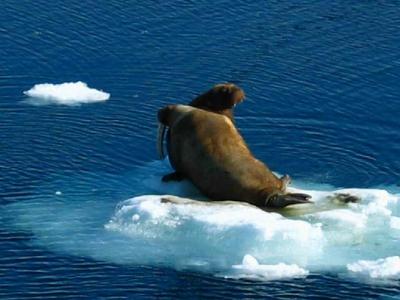20 July, 2003
The sunny skies and the warm temperature of nearly 50 degrees that we
are experiencing have me half-expecting to see palm trees along the
shore. In fact, in my mind's eye, I do see some palm trees on the
beach at Barrow.
What I remember from a previous trip to Barrow are the three or four
palm trees made of whale baleen near the end of the road going north
from town. The baleen trees fancifully decorate someone's hunting
cabin located on the narrow spit of land that separates the Chukchi
Sea from the Elson Lagoon of the Beaufort Sea. This exotic, if
incongruous, picture is completed by thoughtfully-placed chairs that
sit under the "shade" of the palm fronds of this rare forest on the
North Slope.
I can actually see, however, many notable landmarks of this unique
Inupiat community since we are only few miles off shore. Numerous
oil and water tanks, building complexes, and the houses and stores of
town all stand-out in stark contrast from the flat horizon.
Parcticularly scenic is the narrow strip of land that juts out another
three miles from the end of the road into the sea. This is the
"point" of Point Barrow, which is the northern most point of the
continental mainland of North America.
The Inupiat name for Barrow is Ukpiagvik which means (the place for
hunting snowy owls.) I enjoyed watching many Snowy Owls on the
tundra during my work in Barrow two summers ago. On some of my time
off, I was able to help out my friend Denver Holt of the Owl Research
Institute with some of his research on Snowy Owls. That summer,
there were hardly any lemmings to be found scurrying about on the
tundra, so as a result, none of the snowies nested that year because
there wouldn't have been enough lemmings for young, hungry owls to
eat. Denver's work was featured in National Geographic this
past year and you can learn more about his research on the Owl
Research Institute's web site.
Today, of course, there is much more to Barrow than Snowy Owls.
There are over 6000 residents, three quarters of which are Inupiat,
as well as a significant Filipino population and other ethnic groups
that help make Barrow the region's cultural, commercial, and
transportation hub. Even though Barrow enjoys all the modern
conveniences, the Inupiat still look to the land for their cultural
and economic well-being.

The tip of Point Barrow- the northern-most point of continental North America.

Mike Watson's photo of walrus on the edge of the ice near Barrow.
Contact the TEA in the field at
.
If you cannot connect through your browser, copy the
TEA's e-mail address in the "To:" line of
your favorite e-mail package.
|
